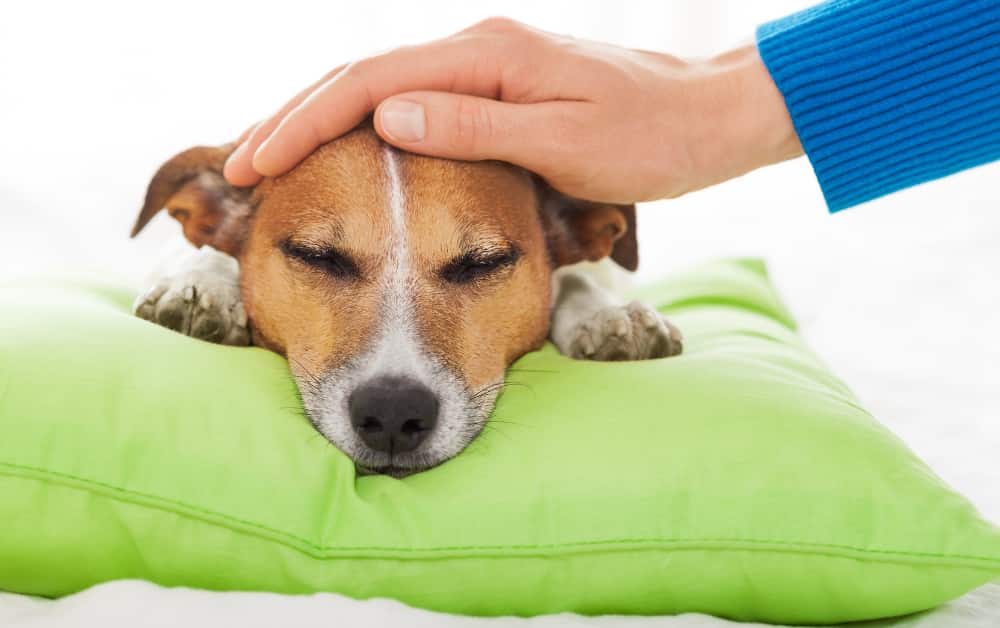Many people wonder if their canine companions can experience menstrual cramps similar to what women go through each month.
This article is a comprehensive guide about canine period cramps, its symptoms and how you can help your dog during periods.
Can dogs have cramps on their period?

Yes, female dogs can get period cramps but not same as like humans. Female canines through a heat cycle just like humans do, but their periods can be very different from what you might experience as a woman. For instance it is not uncommon for female animals to experienced period cramps during this time of the month due to increased hormone levels which cause muscle tension and discomfort in some cases.
Your dog’s heat cycle can be quite uncomfortable for her. She might experience cramping and mild amounts of pain during this time period, which is why it’s so important to keep an eye on your furry friend.
How to Relieve dog period cramps?
1) Make sure your dog is getting enough exercise: A good way to help reduce cramping is to make sure your dog is getting enough physical activity. Exercise helps improve blood circulation and can also help to release endorphins, which can help relieve pain.
2) Try a massage: Gently massaging your dog’s abdomen can help to relax the muscles and relieve cramping.
3) Apply Heat: Applying a heating pad or warm compress to your pooch abdomen can also help to relax the muscles and relieve pain.
4) Change your dog’s diet: If your dog is eating a lot of processed foods, it could be contributing to their cramping. Adding more fresh fruits and vegetables to their diet can help improve their overall health and may also help reduce cramping.
5) Make sure your dog is Hydrated: Dehydration can worsen cramping, so make sure your dog is drinking plenty of water. You can also add electrolytes to their water if they are sweating a lot or if they are vomiting.
6) Give Pain medication: If your pet is in pain, you can give pain medication such as NSAIDs , you should always check with your veterinarian first to make sure the medication is safe for your canine.
7) Try an herbal Remedy: There are a number of herbal remedies that can help relieve cramps and pain. Make sure to ask from your vet or pet nutritionists.
8) Talk to your veterinarian: If your dog’s cramping is severe or if it is accompanied by other symptoms, such as diarrhea or vomiting, it is important to talk to your veterinarian. They will be able to determine the cause of the cramping and recommend the best course of treatment.
How long do dogs periods last?

There is no definitive answer to this question since it can differ based on the individual dog. However, most dogs will have their first heat cycle (or estrus cycle) between 6 and 24 months old.
The duration of heat cycles can also vary, but they typically last around 1-2 weeks. Therefore, periods in dogs usually occur every few months and last for a couple of weeks at a time.
Some dogs may experience more frequent periods, while others may only go into heat once or twice per year. Ultimately, it depends on the dog and her overall health and reproductive cycle.
Dog menstruation Symptoms
Dog menstruation symptoms include changes in behavior, vaginal discharge, and bleeding. These signs can vary from dog to dog, and some canine may not show any outward signs of being in heat.
If you notice any of the below changes in your dog, it’s important to contact your veterinarian for further evaluation.
#1.Behavioral changes

Dogs in heat may become more affectionate or demanding of attention. They may also be more agitated or aggressive than usual. Some dogs may even try to escape their home or yard in search of a mate.
#2. Vaginal Discharge
During Heat, a dog’s vagina will produce a bloody discharge that can range from light pink to deep red in color. This discharge usually lasts for about three weeks and will gradually lessen in amount as the heat cycle comes to an end.
#3. Bleeding
In some cases, your furry friend may experience light bleeding from her vulva during heat. This is perfectly normal and is nothing to be concerned about. However, if the bleeding is heavy or persists for more than a few days, it’s important to contact your veterinarian.
#4. Licking the back rare part
Dogs in heat often lick their rare parts excessively. This helps keep the area clean and free of infection. However, if your puppy is licking her vulva so much that she’s causing herself irritation or pain, it’s important to contact your veterinarian.
Excessive licking can also lead to hair loss in the area.
#5. Appetite Changes
Some dogs may lose their appetite during heat, while others may eat more than usual. If you notice a significant change in your pet eating habits, it’s important to contact your veterinarian.
#6. Weight gain or Loss
Sudden weight gain or loss can be a sign of an underlying health condition and should be evaluated by a veterinarian.
#7. Panting
puppy pant to regulate their body temperature. Panting during heat is normal, but if your dog is panting excessively or seems to be having difficulty breathing, it’s important to contact your veterinarian.
#8. Increased Urination
Dogs in heat often urinate more frequently than usual. This helps them mark their territory and attract mates. If your pooch is urinating so much that she’s causing accidents in the house or seems to be in pain when she goes, it’s important to contact your veterinarian.
#9. Changes in sleep Patterns
Some dogs may sleep more during heat, while others may have trouble sleeping. If you notice a significant change in your pet sleep habits, it’s important to contact your veterinarian.
You May Also Like To Read:
- Why Dogs Rub Against The Wall?
- 9 Proven Tips to stop Flies from Biting Dogs
- Can Dogs Eat Lemon Pepper Seasoning?




![Can Dogs Eat Blood? 7 Side Effects [Expert Opinion]](https://petskor.com/wp-content/uploads/2022/04/Webp.net-resizeimage-12.jpg)
